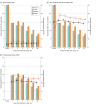Post-COVID-19 Condition Fatigue Outcomes Among Danish Residents
- PMID: 39374018
- PMCID: PMC11581651
- DOI: 10.1001/jamanetworkopen.2024.34863
Post-COVID-19 Condition Fatigue Outcomes Among Danish Residents
Abstract
Importance: Fatigue remains one of the most common and debilitating symptoms of post-COVID-19 condition; however, existing studies are limited to select populations and often lack noninfected controls. It also remains unclear to what extent severity of infection and psychiatric conditions, which are often linked to chronic fatigue, modify the risk of post-COVID-19 condition fatigue symptoms.
Objective: To evaluate the impact of SARS-CoV-2 infection on self-reported fatigue and postexertional malaise over time and to explore possible risk factors, such as the impact of acute SARS-CoV-2 hospitalization and preexisting psychiatric conditions on postacute fatigue.
Design, setting, and participants: In this cohort study, Danish residents aged 15 years and older were invited to participate in the EFTER-COVID survey, which used repeated, self-reported online questionnaires that collected information on fatigue (Fatigue Assessment Scale) and postexertional malaise scores (DePaul Symptom Questionnaire) after individuals' index SARS-CoV-2 polymerase chain reaction test. Participants were included if they completed a baseline and at least 1 follow-up questionnaire 2 to 18 months after testing for SARS-CoV-2.
Exposure: Testing for SARS-CoV-2 infection.
Main outcomes and measures: The primary outcomes were fatigue and postexertional malaise 2 to 18 months after testing. Mixed-effects models were used to compare scores between SARS-CoV-2 test-positive and test-negative individuals (testing period April 2021 to February 2023).
Results: Of a total of 50 115 participants (median [IQR] age at test date, 57 [46-67] years; 29 774 female [59.4%]), 25 249 were test positive and 24 866 were test negative. Most participants were vaccinated with at least 2 doses (21 164 test-negative participants [85.1%] and 22 120 test-positive participants [87.6%]) before their SARS-CoV-2 index test and fatigue reporting. In the period 2 to 18 months after testing, SARS-CoV-2 infection was associated with a small but significant 3% increase in self-reported fatigue scores (score ratio [SR], 1.03; 95% CI, 1.03-1.04) and higher odds of self-reported postexertional malaise (odds ratio, 2.04; 95% CI, 1.81-2.30), compared with test-negative participants. In the same period, hospitalization with SARS-CoV-2 increased fatigue scores by 23% (SR, 1.23; 95% CI, 1.20-1.26) compared with test-negative participants. Preexisting psychiatric conditions did not significantly modify postacute fatigue scores.
Conclusions and relevance: In this cohort study, SARS-CoV-2 infection was associated with a subtle increase in self-reported fatigue and postexertional malaise symptoms 2 to 18 months after mild infection. In contrast, individuals hospitalized with acute SARS-CoV-2 experienced a more substantial increase in postacute symptoms. Preexisting psychiatric conditions did not significantly modify the risk of postacute fatigue symptoms. The findings largely captured symptoms following first-time infections in a population where most had been vaccinated. Persons who experienced severe acute infection may benefit from clinical follow-up for fatigue.
Conflict of interest statement
Figures




Similar articles
-
Postacute symptoms 4 months after SARS-CoV-2 infection during the Omicron period: a nationwide Danish questionnaire study.Am J Epidemiol. 2024 Aug 5;193(8):1106-1114. doi: 10.1093/aje/kwad225. Am J Epidemiol. 2024. PMID: 37981717 Free PMC article.
-
A prospective, randomized, single-blinded, crossover trial to investigate the effect of a wearable device in addition to a daily symptom diary for the remote early detection of SARS-CoV-2 infections (COVID-RED): a structured summary of a study protocol for a randomized controlled trial.Trials. 2021 Jun 22;22(1):412. doi: 10.1186/s13063-021-05241-5. Trials. 2021. PMID: 34158099 Free PMC article.
-
Persistent symptoms and clinical findings in adults with post-acute sequelae of COVID-19/post-COVID-19 syndrome in the second year after acute infection: A population-based, nested case-control study.PLoS Med. 2025 Jan 23;22(1):e1004511. doi: 10.1371/journal.pmed.1004511. eCollection 2025 Jan. PLoS Med. 2025. PMID: 39847575 Free PMC article.
-
A prospective, randomized, single-blinded, crossover trial to investigate the effect of a wearable device in addition to a daily symptom diary for the Remote Early Detection of SARS-CoV-2 infections (COVID-RED): a structured summary of a study protocol for a randomized controlled trial.Trials. 2021 Oct 11;22(1):694. doi: 10.1186/s13063-021-05643-5. Trials. 2021. PMID: 34635140 Free PMC article.
-
Antibody tests for identification of current and past infection with SARS-CoV-2.Cochrane Database Syst Rev. 2020 Jun 25;6(6):CD013652. doi: 10.1002/14651858.CD013652. Cochrane Database Syst Rev. 2020. Update in: Cochrane Database Syst Rev. 2022 Nov 17;11:CD013652. doi: 10.1002/14651858.CD013652.pub2. PMID: 32584464 Free PMC article. Updated.
References
Publication types
MeSH terms
LinkOut - more resources
Full Text Sources
Medical
Research Materials
Miscellaneous

